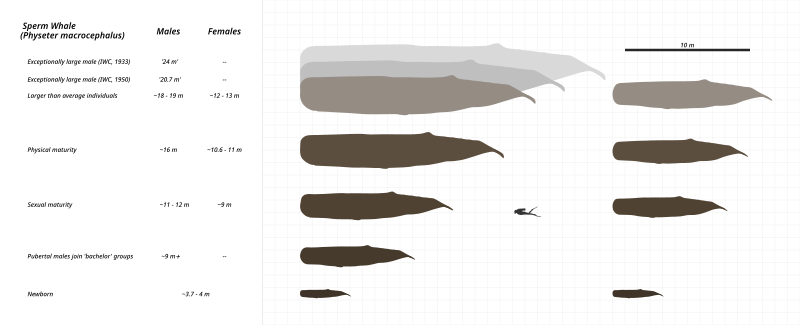| DescriptionSperm-Whale-Scale-Chart-SVG-Steveoc86.svg |
English: The size of sperm whales (Physeter macrocephalus) at various growth and maturity stages. Showing a newborn, sexually mature male and females, physically mature male and females, larger than average male and females, and a couple of exceptionally large males, with a human diver for scale. Males are shown on the left, females are shown on the right.
- • Newborn sperm whales are between 3.7 to 4.3 meters (12 to 14 ft) in length.[1]
- • Sperm whales exhibit a large amount of sexual dimorphism with their size and proportions, with males generally being much larger than females. Female sperm whales are sexually mature at 8 to 9 meters (26 to 30 ft) in length, and physically mature at about 10.6 to 11 meters (35 to 36 ft), on average. At around 9 metres (30 ft) or more, pubertal male sperm whales will leave their family pod to join bachelor groups. Male sperm whales are sexually mature at 11 to 12 meters (36 to 39 ft), and physically mature at about 15 to 16 meters (49 to 52 ft) in length, on average. Larger-than-average females have been generally recorded around 12 to 13 meters (39 to 43 ft), and larger-than-average males are usually stated to reach a maximum of about 18 to 19 meters (59 to 62 ft).[2][3][4][5][6][7][8][9]
- • Exceptionally sized individuals that greatly exceed the average sizes have been reported to the International Whaling Commission (IWC).[5] However, there is disagreement as to the largest accurately recorded sperm whale. Historical accounts have suggested adult males approaching or exceeding ~80 ft (~24 m). Some authors are sceptical of these claims and consider them to be exaggerations, possibly measured along the curves of the body instead of straight-line distance or including the flukes.[6][7] Some authors consider a 20.7 metres (68 ft) male reported in 1950 the largest recorded.[7][10] However, larger males have been reported in the IWC whaling records, including a male reported at 24 metres (79 ft) in length in 1933, supported by McClain et al. (2015) as the largest 'measured length'.[5][10] Regardless of the exact size of the largest males, exceptionally large sperm whales are very rare, with 95% of sperm whales measured being below 15 metres (49 ft). There is also evidence that the average size of sperm whales has reduced over time, possibly due to heavy whaling.[5][6] However, this probably does not explain the difference in size between the more extreme historical accounts & records and more recent records.[6]
- • The proportions of sperm whales change as they grow, most noticeably in the size and shape of the head. At birth, the heads of both sexes are similar in size in relation to the rest of the body, at around 25-26% of the total length. The head in a physically mature female might reach around 28% of the total body length. The heads of young males start off being similar in size to those of females. However, as males go through puberty, their heads start to grow rapidly, greatly exceeding the head-to-body ratio of females. The head of a 16 metres (52 ft) physically mature male is typically around 35 - 36% of the total length.[11][12] The largest silhouettes here are inspired by the details of a 17.6 metres (58 ft) male with a head that was 39% the total length.[13]
- • Note: Whales are usually measured from the most forward part of the head to the notch between tail flukes on a flat surface.[5] The tail flukes add some additional length to the silhouettes above.
References
- ↑ Ruelas-Inzunza, J (2002-09-01). "Distribution of Cd, Cu, Fe, Mn, Pb and Zn in selected tissues of juvenile whales stranded in the SE Gulf of California (Mexico)". Environment International 28 (4): 325–329. DOI:10.1016/S0160-4120(02)00041-7. ISSN 0160-4120.
- ↑ Dufault, S (1999). "An examination of the current knowledge on the stock structure of sperm whales (Physeter macrocephalus) worldwide". J. Cetacean Res. Manage 1 (1): 1–10.
- ↑ Whitehead, Hal (2018-01- 01), “Sperm Whale: Physeter macrocephalus”, in Encyclopedia of Marine Mammals (Third Edition)[1], Academic Press, DOI:10.1016/b978-0-12-804327-1.00242-9, ISBN 978-0-12-804327-1, pages 919–925
- ↑ Shirihai, H. and Jarrett, B. (2006) Whales, Dolphins, and Other Marine Mammals of the World, Princeton: Princeton Univ. Press, pp. 21–24 ISBN: 0-691-12757-3.
- ↑ a b c d e McClain, Craig R. (2015-01-13). "Sizing ocean giants: patterns of intraspecific size variation in marine megafauna". PeerJ 3: e715. DOI:10.7717/peerj.715. ISSN 2167-8359.
- ↑ a b c d Ellis, Richard (2011) The Great Sperm Whale: A Natural History of the Ocean's Most Magnificent and Mysterious Creature, Zoology, 179, United States of America: University Press of Kansas, p. 432 ISBN: 978-0-7006-1772-2.
- ↑ a b c Wood, Gerald (1983) The Guinness Book of Animal Facts and Feats ISBN: 978-0-85112-235-9.
- ↑ Perry, Simona L. (1999) The Great Whales: History and Status of Six Species Listed as Endangered Under the U.S. Endangered Species Act of 1973, NMFS Publications Office, pp. 1−74
- ↑ Nowak, Ronald M. (2003) Walker's marine mammals of the world, Johns Hopkins University Press ISBN: 0-8018-7343-6. OCLC: 492136449.
- ↑ a b Carwardine, Mark (2008) Animal Records, Category:New York: Sterling ISBN: 9781402756238.
- ↑ Nishiwaki, Masaharu (1963). "Change of form in the sperm whale accompanied with growth.". Scientific Reports of the Whales Research Institute, Tokyo 17.
- ↑ Clarke, R. (1972). "SPERM WHALES OF THE SOUTHEAST PACIFIC. PART III: MORPHOMETRY". DET NORSKE VIDENSKAPS-AKADEMI I OSLO.
- ↑ Nakamura, Gen (2013-09). "Relative Skull Growth of the Sperm Whale, Physeter macrocephalus, with a Note of Sexual Dimorphism". Mammal Study 38 (3): 177–186. DOI:10.3106/041.038.0306. ISSN 1343-4152.
|





